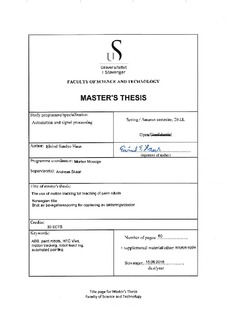| dc.contributor.advisor | Mossige, Morten | |
| dc.contributor.author | Haus, Eivind Sandve | |
| dc.date.accessioned | 2018-09-26T13:26:50Z | |
| dc.date.available | 2018-09-26T13:26:50Z | |
| dc.date.issued | 2018-06 | |
| dc.identifier.uri | http://hdl.handle.net/11250/2564767 | |
| dc.description | Master's thesis in Automation and signal processing | nb_NO |
| dc.description.abstract | Most industrial production processes require parts to be painted, both for aesthetic and quality purposes. The painting process is often automated with the benefits of better paint coverage, less waste of paint, high consistency between batches and reduced production time. One way to automate this process is to mount a spray-painting gun on an industrial robot. The robot then moves along a preprogrammed path and covers the object in paint.
Before it can be used the robot must be programmed. This consists of determining the path the robot should follow and when it should spray paint. A new paint program must be made every time the product is changed or a new part needs to be painted. This project has developed an intuitive and efficient way of creating said paint programs.
The approach is to use the fluid motion of the human arm and experience of painters to create the robot’s path. This is performed with the use of motion tracking technology. The operator holds a hand held device which is tracked in three-dimensional space. When the operator moves the device as if painting the object, the traced path is recorded and used to create the paint program. The virtual reality system HTC Vive has been used for the motion tracking. It has shown promising results in precision and reliability in the past, which have been confirmed by this project.
The project has implemented an interface to retrieve information from the HTC Vive system. Two approaches to the paint program creation has been developed. The first approach records the path independently of the robot and creates the paint program. It is then loaded onto the robot and can be used to paint the object. The second approach uses motion tracking to control the robot in real-time. While the operator controls the robot the object is painted and the path is recorded. The path is then used to create the paint program which can be loaded onto the robot to paint new objects.Both of the implemented solutions have shown promising results. They allow the user to create simple paint programs in a matter of minutes with little to no training needed. There are some limitations when creating more advanced paint programs, especially in regards to determining the correct orientation of the paint gun tool. More work would be necessary to make the implemented solutions ready to be used commercially. | nb_NO |
| dc.language.iso | eng | nb_NO |
| dc.publisher | University of Stavanger, Norway | nb_NO |
| dc.relation.ispartofseries | Masteroppgave/UIS-TN-IDE/2018; | |
| dc.subject | informasjonsteknologi | nb_NO |
| dc.subject | kybernetikk | nb_NO |
| dc.subject | signalbehandling | nb_NO |
| dc.subject | ABB | nb_NO |
| dc.subject | paint robots | nb_NO |
| dc.subject | HTC Vive | nb_NO |
| dc.subject | motion tracking | nb_NO |
| dc.subject | robot teaching | nb_NO |
| dc.subject | automated painting | nb_NO |
| dc.title | The use of motion tracking for teaching of paint robots | nb_NO |
| dc.type | Master thesis | nb_NO |
| dc.subject.nsi | VDP::Teknologi: 500::Informasjons- og kommunikasjonsteknologi: 550 | nb_NO |
